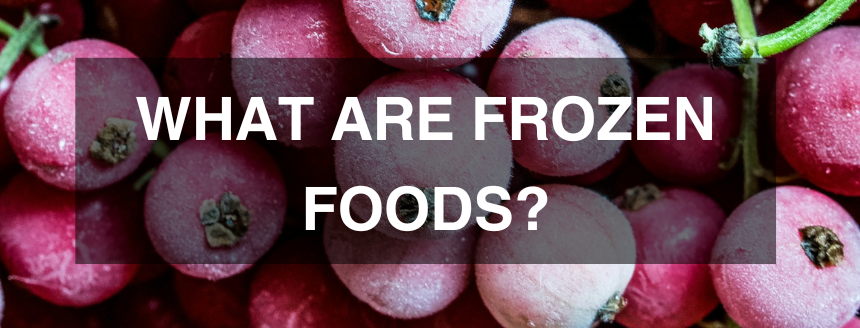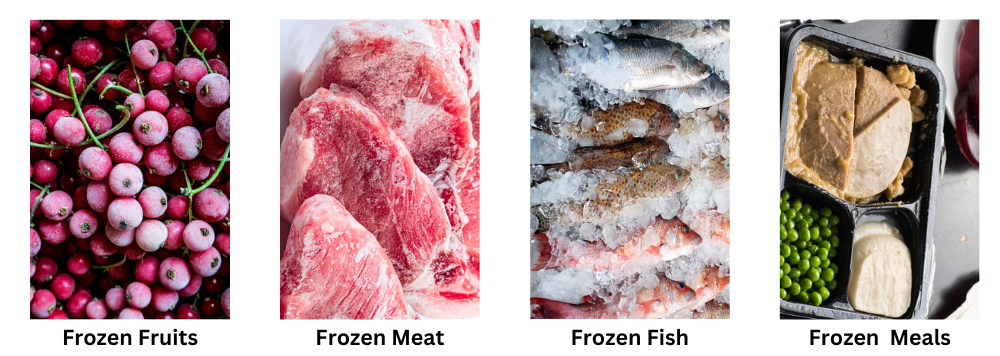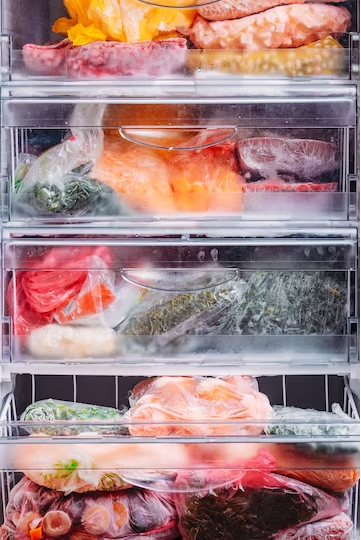
Frozen Foods are getting popular every year. The global frozen food market was valued at 260.8 billion US dollars in 2018 and is projected to grow at a rate of 40% by 2026 to 366.3 billion US dollars. Frozen Food has become an inseparable part of the lives of millions of fast-working people. Frozen Food offers convenience and saves consumers time. However, a lot of misconceptions and misinformation flood our lives. Here in this article, we uncover the science behind Frozen Foods and reveal their secrets. So, Hold on, and let’s uncover each layer of this Frozen Food Onion.
What Are Frozen Foods?
Frozen Foods are food items that are preserved by freezing, usually at temperatures of 0°F (-18°C) or lower for longer shelf life. Freezing the food stops the activity of enzymes and microorganisms present in the food leading to increased shelf life.
Frozen Foods: Uncovering the Hidden
How is Freezing done in Food Preservation?
Freezing of Food is achieved commercially via two methods: mechanical and cryogenic. Since the freezing process is different, the results are also different.
Mechanical Freezing:
This method relies on a compressor and evaporator to remove heat from the source(food). This is the most common method used for commercially preparing frozen food products.
Cryogenic Freezing:
This method is comparatively expensive and uses liquid nitrogen or liquid carbon dioxide to rapidly freeze food. This is less common than mechanical freezing due to its high cost but produces comparatively better food products.
Mechanical vs Cryogenic Freezing:
| Mechanical Freezing | Cryogenic Freezing | |
| Freezing Temperatures | Typically -30°F | Typically, -160°F or lower for Liquid Nitrogen and -80°F for liquid Carbon dioxide. |
| Food Quality | Less than 1% dehydration loss preserves texture and flavor | Slower Freezing can result in surface dehydration and weight loss |
| Sustainability | Environmentally Friendly | Ammonia used is highly toxic |
What does Freezing do to the Food?
Freezing the food at extremely low temperatures transforms the moisture inside the food into ice. Rapid freezing generates smaller-sized ice crystals maintaining cellular structure and thereby the texture. It also preserves the flavors of the food better than mechanical freezing.
What do the low temperatures and ice formation do to the food?
The maintenance of low temperatures in the case of frozen foods and the formation of ice does the following;
- It Inhibits the growth of microorganisms that spoil the food
- Render the enzymes in the food inactive. The low temperatures preserve the enzymes that can regain their activity upon reaching their optimum temperature range.
- Slows the natural decomposition of the nutrients in the food.
What are Freezing Burns in Frozen Foods?
Sometimes due to the formation of ice on the upper layer of food or due to contact with air, there occurs differential dehydration of the upper layer causing it to dry out, decolorise, and appear different in texture. This is mainly due to packaging issues and can be avoided by proper packaging.
Do Frozen Foods contain Preservatives?
Contrary to popular belief, most Frozen Foods do not contain added preservatives. This is because Freezing itself works as a very effective method of preservation. Freezing causes the formation of ice crystals and prevents microbial growth.
However, processed foods such as TV dinners, pizza, and burgers, may contain some added preservatives to maintain the color and texture of food and also to prevent oxidation, and mold growth. This extends the shelf-life further.
What are the most common preservatives found in Processed Frozen Foods?
Tertiary butylhydroquinone/TBHQ
A common anti-oxidant that prevents oxidation(breakdown) of fats. Oxidation causes loss of flavor, nutrients, and change in appearance. A 2004 European Food Safety Authority (EFSA) 2004 Panel found TBHQ to be non-carcinogenic. TBHQ is approved by leading global regulatory organizations such as EFSA, the U.S. Food and Drug Administration(FDA), and JECFA. Source
BHA(Butylated hydroxyanisole) and BHT(Butylated hydroxytoluene)
From Beef-based dinners to burgers, BHA and BHT are quite common in frozen foods. There is a lot of debate around whether or not BHA and BHT are carcinogenic to humans. The International Agency for Research on Cancer(IARC) has found sufficient evidence for the carcinogenicity of BHA in experimental animals, but no data for humans. Studies on BHT concluded that there is limited evidence for its carcinogenicity in experimental animals, and no data for humans. Source
What Kinds of foods are generally frozen?
It is not possible to freeze all types of food for a very long shelf life. Only certain particular food types have been preserved for longer shelf life.
- Fruits and vegetables: They are frozen at peak ripeness to help lock in nutrients and flavor. Some of the most common frozen fruits and vegetables are berries, corn, peas, broccoli, and spinach.
- Meat and poultry: Meat and poultry products are the most common frozen foods as they are both convenient and affordable options. It is very important to thaw these foods properly to avoid foodborne illness.
- Seafood: Frozen seafood helps to fill our plates with delicious seafood all around the year. Popular frozen seafood includes salmon, shrimp, tuna, etc.
- Prepared meals: Frozen prepared meals have fueled the development of both nations as well as families. They can be a lifesaver on busy nights. They are generally looked upon as they are high in sodium and unhealthy fats. It is suggested to read the label carefully before choosing.

If chosen properly by reading carefully the label and cooking them properly as per instructions. Frozen foods can also become a healthy option. Keep reading more to find out how you can make better choices when it comes to frozen foods.
Frozen Foods: A Necessary Evil or a Misunderstood Wonder?
Frozen Foods have come a long way from frozen sea-catch delivered to the needy to prep meals on the go. This evolution of frozen foods has been made possible for two reasons: the need to stop food wastage and feed millions of hungry mouths around the world and the development of freezing technologies that allow rapid freezing under low-cost investments.
Frozen Foods have become an integral part of the modern family where everyone is out to earn a living and make a space for themselves. This has been made possible because of frozen foods that can instantly turn a gloomy night into a candlelight dinner. Of course, everything comes at a cost and we were replacing freshly picked food items with packaged ones. But there’s a catch, with increasing distances from the source of production and cities and townships becoming densely populated. There arose a need to deliver food to every household and that too very quickly. Freshly prepared meals sadly do not last long and can only be delivered up to a certain distance. This is where frozen food jumps in to save the day and Hurray!
Journey of Frozen Foods: From Ice Boxes to Instant Meals
Since early times, humans have been using ice and snow to preserve various food items. They were aware of the effects of cold and used cold(unheated) basements during winter to preserve their food stocks.
The world’s first freezing workshop was established by Thomas Sutcliffe Mort at Darling Harbour, Sydney, Australia which later became the NEW South Wales Fresh Food and Ice Company. It was Thomas who financed experiments by a French-born engineer Dominic Nicolle who arrived in Sydney and registered his first Ice-making patent. The first recorded shipment of frozen meat to London was reported in 1868.
By 1899, A food importing business “Baerselman Bros” was shipping meat from Russia to England. But the turn in the Frozen Food industry was just around the corner. The modern frozen food industry emerged in the early 20th century when Clarence Birdseye, an American inventor introduced the world to the techniques of flash freezing. This technique of Birdseye remarkably preserved the freshness, nutrients, flavor, and texture of the food. This was the turning point in the frozen food industry as this innovation led the way to mass production and distribution of frozen food to needy consumers.
The early days of the industry were dominated by single-serve items like frozen veggies and fruits. It was only during and after the war that through the efforts of the U.S. government, we saw the rise and popularisation of frozen prep meals from iconic brands like Swanson’s TV dinners becoming staples in American households.
These TV dinners were reportedly criticized for being high in sodium, unhealthy fats, and a lack of variety. However, the frozen food industry has only grown since then shedding light on the fact that they cater to a section of society that is not enslaved by options but rather that frozen foods fill a gap that otherwise remains unfilled.
Frozen Food: Present and the Future
The recent shift in consumer choices and the demand for healthier food options has impacted the frozen food industry to offer a variety of options that fulfill consumer demands as per consumer choices. Consumers are increasingly demanding more healthier, natural, and convenient options.
Consumer demand has led to the development of new innovative food products in the frozen food section such as;
- Flash-frozen fruits and Vegetables: Fruits and Vegetables are flash-frozen to contain their nutrients, aroma, and flavor and to maintain their texture.
- Pre-cut and seasoned fruits and vegetables: To make your cooking faster, pre-cut and seasoned vegetables add to your buy-it to save my time list.
- Plant-based meals: With ever-increasing demand for sustainability, more people are looking for vegan options and plant-based meals serve just that.
- Global Prepared Meals: With the internet bringing cultures closer, more people are aware of inter-continental food options and lurk in to catch one always. More and more food options including prep meals from different countries are filling the shelves of Walmart freezers every day.

The future of Frozen Foods looks promising with more and more newly discovered food recipes being brought to the general masses. Social media platforms and influencers are introducing food dishes to the people that they can crave and order but hardly do the consumers know about the long journey their food undertakes to reach them.
What are the advantages of Frozen Foods?
Frozen Food demand has been increasing over the years and that too for good reasons as they serve vital purposes:
- Convenience: Most Frozen Foods are pre-washed, some are pre-seasoned, and some are even pre-cooked. Such options are the go-to choices for busy customers.
- Affordability: The incurred cost due to spoilage increases the cost of fresh products. Frozen products are relatively cheaper.
- Nutritional Value: In several studies, the nutritional value of frozen food comes at par with packaged fresh foods. This is because freezing stops the natural decomposition of the nutrients.
- Availability: Frozen Foods offers year-round availability of your favorite fruits, vegetables, and meals.
- Less Variation: Freezing helps to preserve the state of the food intact. Properly frozen food and later properly thawed and cooked frozen food offer a similar taste every time you put your dinner in the oven.
What are the Drawbacks of Frozen Foods?
Frozen Foods offer great choices but as with everything else, there’s a silver lining. Here, we reveal some of the common drawbacks of Frozen Foods.
- High Sodium Content: Some of the Frozen Food products contain high values of sodium. We should check the labels and make informed decisions rather than be infatuated with the marketing hoax.
- Preservatives and Artificial colors: Some Frozen Products do contain preservatives and artificial colors. Not all preservatives are equally harmful to humans. We should read the label and then choose. Let us know if you want to know more about preservatives in Frozen Food.
- Less Variety: This is not entirely true for the enormous pool of Frozen Food products. However, there is a limited shelf space in your local mart and this is why you have encountered much less variety. Some countries such as Korea and Japan offer a much wider range to their customers.
How Can I Choose Healthy Frozen Food Products?
We believe that if you follow these steps, you can make an informed choice that can help you save both time and money and find the right balance between health and convenience.
- Read the Label Carefully: Check the label to see what added preservatives and artificial compounds are there in your food. Check the label for sodium, fat, and sugar contents.
- Minimally Processed Food: Choose options that offer products with minimal processing, added flavors, color, and preservatives.
- Compare and Choose: Usually, the same food product is offered by many brands. Compare the brands and choose the best option. Also, sometimes the same parent company offers many products under different brand names to fool consumers.
- Making the Right Choice: A choice such as buying whole fruits and vegetables over pre-cut and seasoned is better as cutting the vegetables and fruits exposes more surface area for contamination. Also, the greater the exposed surface area, the greater would be the loss of aroma and texture.
Frequently Asked Questions
What are some Frozen Foods?
Some of the most common Frozen Foods are:
- Frozen Peas
- Chips
- Fish-Fillets
- Ice-creams
- Pizza
- Sausages
- Plain Chicken
- Readymade Meals
- Chicken
- Burgers
- Green Beans
- Roasted Potatoes
- Desserts
What are the most common Frozen Foods in the USA?
Some of the most common Frozen Foods in the USA are:
- Pizza
- Ice cream
- Vegetables
- Chicken nuggets
- French fries
- TV dinners
- Fruits
- Fish
- Waffles
What are some Popular Frozen Food Brands in the USA?
Some of the most Popular Food Brands in the USA are:
- Nestle
- Conagra Brands
- General Mills
- Tyson Foods
- Dr. Oetker
- Mccain Foods
- Schwan’s Company
- Kraft Heinz Food Company
- Pinnacle Foods
- Bruno Specialty Foods
- Fairmont Foods
- Frozen Specialties
What are some Popular Dinner Brands?
Some Popular Dinner Brands are:
- Rao’s
- Amy’s
- Trader Joe’s
- Dr. Praeger’s
- Saffron Road
- Kashi
- Primal Kitchen
- Feel Good Foods
- Michelina’s
- Stouffer’s
- Marie Callender’s
- Caulipower
- Frontera
- Lean Cuisine
